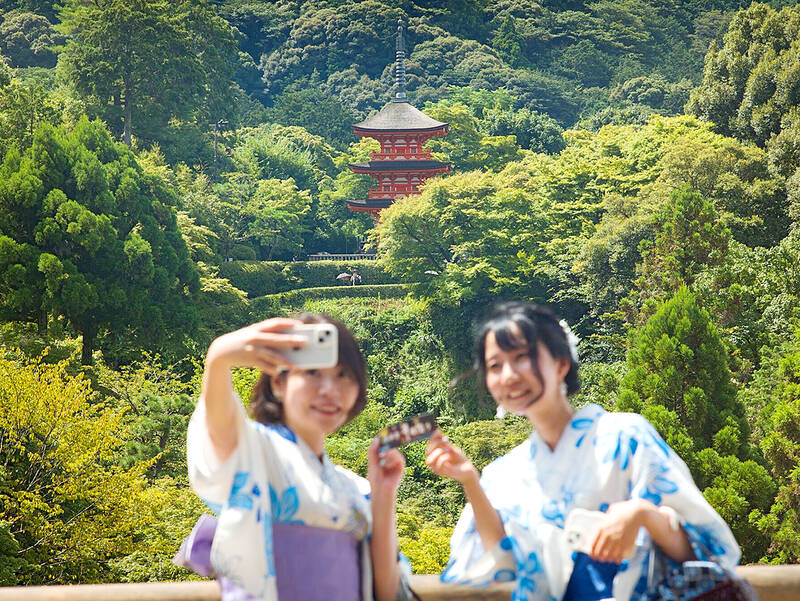They are heavy disks of cast iron that separate us from our subterranean sewage, but in Japan, they are also highly coveted works of art, symbols of regional pride, and now, sources of revenue.
Local authorities are cashing in on the public’s fascination with the country’s decorated manhole covers, with Kyoto now joining a list of locations that are putting obsolete lids up for sale.
The city’s government has said it will sell iron manhole covers to members of the public for the first time, according to the Mainichi Shimbun.

Photo: Bloomberg
At ¥3,000 (US$20) apiece, the covers — manufactured in 1978, 1981 and 1990 — would be considered a steal by collectors keen to own a slice of the city’s history in the form of a 90kg piece of industrial art. According to media reports, new manhole covers cost around ¥60,000 each.
One of the covers features a pattern reminiscent of the wheels of a court carriage — a reference to Kyoto’s time as Japan’s ancient capital. Another has a grid-like motif. All three have acquired a rusty sheen and plenty of scratches during at least three decades of service on Kyoto’s streets.
The eastern city of Maebashi attracted a flood of applications after it put 10 manhole covers on sale in 2017, with almost 200 potential buyers, including from people living outside the city, according to the Kyodo news agency.
Tokorozawa, a city north of Tokyo, is one of several municipalities to have cashed in on the manhole craze. In 2018, it came up with the idea of commercializing the items when it invited firms to advertise on manhole covers in an attempt to finance its heavily indebted sewage management system.
Manhole cover designs from all 17 of Japan’s prefectures have found their way on to collectible cards, keyrings and coasters, as well as T-shirts and tote bags sold by the apparel firm Japan Underground.
Staff visited every prefecture in person to select lid designs and gain permission to reproduce them from local authorities, according to the SoraNews 24 Web site. The firm launched five designs from the northernmost prefecture of Hokkaido in 2021, and completed the range this month with those based on covers from the southernmost prefecture of Okinawa.
Japan’s artistic manhole covers are embellished with thousands of colorful illustrations of everything from local landmarks, famous natives, festivals and flora and fauna. Popular culture also gets a look in, with lids featuring Pokemon characters now adorning paths in most parts of the country.
Enthusiasts, nicknamed “manholers,” indulge their love of the items at an annual manhole summit. Last year’s event was held in Tokorozawa, appropriately enough on the former site of the city’s sewage treatment facility.
According to Kyoto’s water supply and sewerage bureau, the city is home to about 160,000 manhole covers. Those installed on roads have a service life of about 15 years, while those used on pavements last about 30 years, the Mainichi said.
With 1,500 lids replaced every year, the city is expected to continue finding them new owners.
“We’ll sell three to begin with, and if it’s a success, we would like to sell more,” a sewerage bureau official told the newspaper.

June 23 to June 29 After capturing the walled city of Hsinchu on June 22, 1895, the Japanese hoped to quickly push south and seize control of Taiwan’s entire west coast — but their advance was stalled for more than a month. Not only did local Hakka fighters continue to cause them headaches, resistance forces even attempted to retake the city three times. “We had planned to occupy Anping (Tainan) and Takao (Kaohsiung) as soon as possible, but ever since we took Hsinchu, nearby bandits proclaiming to be ‘righteous people’ (義民) have been destroying train tracks and electrical cables, and gathering in villages

Dr. Y. Tony Yang, Associate Dean of Health Policy and Population Science at George Washington University, argued last week in a piece for the Taipei Times about former president Ma Ying-jeou (馬英九) leading a student delegation to the People’s Republic of China (PRC) that, “The real question is not whether Ma’s visit helps or hurts Taiwan — it is why Taiwan lacks a sophisticated, multi-track approach to one of the most complex geopolitical relationships in the world” (“Ma’s Visit, DPP’s Blind Spot,” June 18, page 8). Yang contends that the Democratic Progressive Party (DPP) has a blind spot: “By treating any

This year will go down in the history books. Taiwan faces enormous turmoil and uncertainty in the coming months. Which political parties are in a good position to handle big changes? All of the main parties are beset with challenges. Taking stock, this column examined the Taiwan People’s Party (TPP) (“Huang Kuo-chang’s choking the life out of the TPP,” May 28, page 12), the Democratic Progressive Party (DPP) (“Challenges amid choppy waters for the DPP,” June 14, page 12) and the Chinese Nationalist Party (KMT) (“KMT struggles to seize opportunities as ‘interesting times’ loom,” June 20, page 11). Times like these can

Swooping low over the banks of a Nile River tributary, an aid flight run by retired American military officers released a stream of food-stuffed sacks over a town emptied by fighting in South Sudan, a country wracked by conflict. Last week’s air drop was the latest in a controversial development — private contracting firms led by former US intelligence officers and military veterans delivering aid to some of the world’s deadliest conflict zones, in operations organized with governments that are combatants in the conflicts. The moves are roiling the global aid community, which warns of a more militarized, politicized and profit-seeking trend